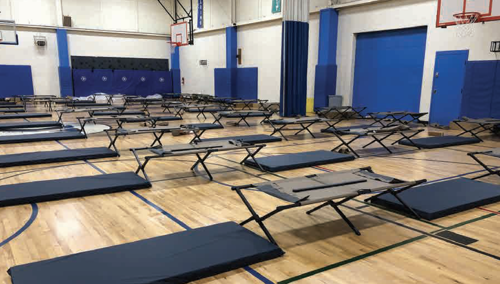The first move for the YMCA of Central Ohio, when the pandemic struck, was a critical one. Knowing women, men, and children were already in overcrowded shelters around the city, the priority was to decentralize its locations to ensure social distancing and reduce the spread of the virus.
That’s not an easy task when you consider YMCA is the largest supportive housing provider for the homeless in central Ohio, with 1,800 people under its roofs before the crisis—more than 700 at the Van Buren Center, and 1,100 in permanent supportive housing.

The YMCA utilized additional space during the early days of the pandemic, including the gymnasium at the Hilltop YMCA. Photo courtesy of YMCA of Central Ohio.
“Coming into the crisis, the Van Buren Center, our shelter for women and families, was so over capacity that not only could we not take on more when people were told to stay at home, but the people already in the emergency shelter couldn’t safely distance themselves,” said Tony Collins, CEO of the YMCA of Central Ohio. “We immediately needed to decentralize our shelters and find spaces to put the people we were currently serving.”
One silver lining was the existing collaborative relationship of Columbus’ shelter system.
“The Community Shelter Board network is very unique to Columbus,” Collins said. “It is an incredibly collaborative atmosphere developed to make sure the continuum of housing is dealt with and people, wherever they are in their life, have a resource.”
Collins knew that network would be key, and the YMCA had to work with other shelter providers to find a solution, since all were at capacity.
“Membership services were closed at our Downtown YMCA location on Long Street, so we looked at that closure as an opportunity to provide emergency shelter to 140 individuals,” Collins explained. “We were also able to work with Columbus Recreation and Parks and decentralize even further by placing a group of men, age 65 and older, at Sullivant Gardens Recreation Center.”
Collins said it can take six months under normal circumstances to set up a shelter. They had Long Street open in about a week.
With Van Buren still too crowded, the YMCA took 60 women and moved them over to the Hilltop YMCA so only families remained at Van Buren.
In addition to keeping the virus at bay, Collins knew that the clients being served were more at risk of developing COVID-19.
“Our priority was to focus on the hierarchy of needs. The first thing we did was focus where we could lean in. Where can we help?”
TONY COLLINS, CEO of the YMCA of Central Ohio
“We knew, given the transient lifestyle and all the challenges that our clients see, they would be very susceptible to the virus,” he said. “We also realized when it does impact them, it would hit them hard because of their vulnerabilities.”
The YMCA worked with the Community Shelter Board to set up an isolation shelter so that those who were diagnosed or showed symptoms had a safe place to stay, receive telehealth services, and recover from the virus.
Collins credits his staff, who persevered through multiple challenges to support those they work with on a daily basis.
“Our staff demonstrates strength and courage. We have provided a service to the community that many may never know about, but the folks who have done it have done it with a cause-driven mindset in knowing that it’s our role to serve. That’s been pretty incredible.”
The Columbus Foundation’s Emergency Response Fund was activated on Monday, March 9, to help Franklin County nonprofit organizations as they assist those in our community affected by the Coronavirus pandemic. Within a week of launching the fund, grants were already being deployed to help nonprofits support the most vulnerable in our community.